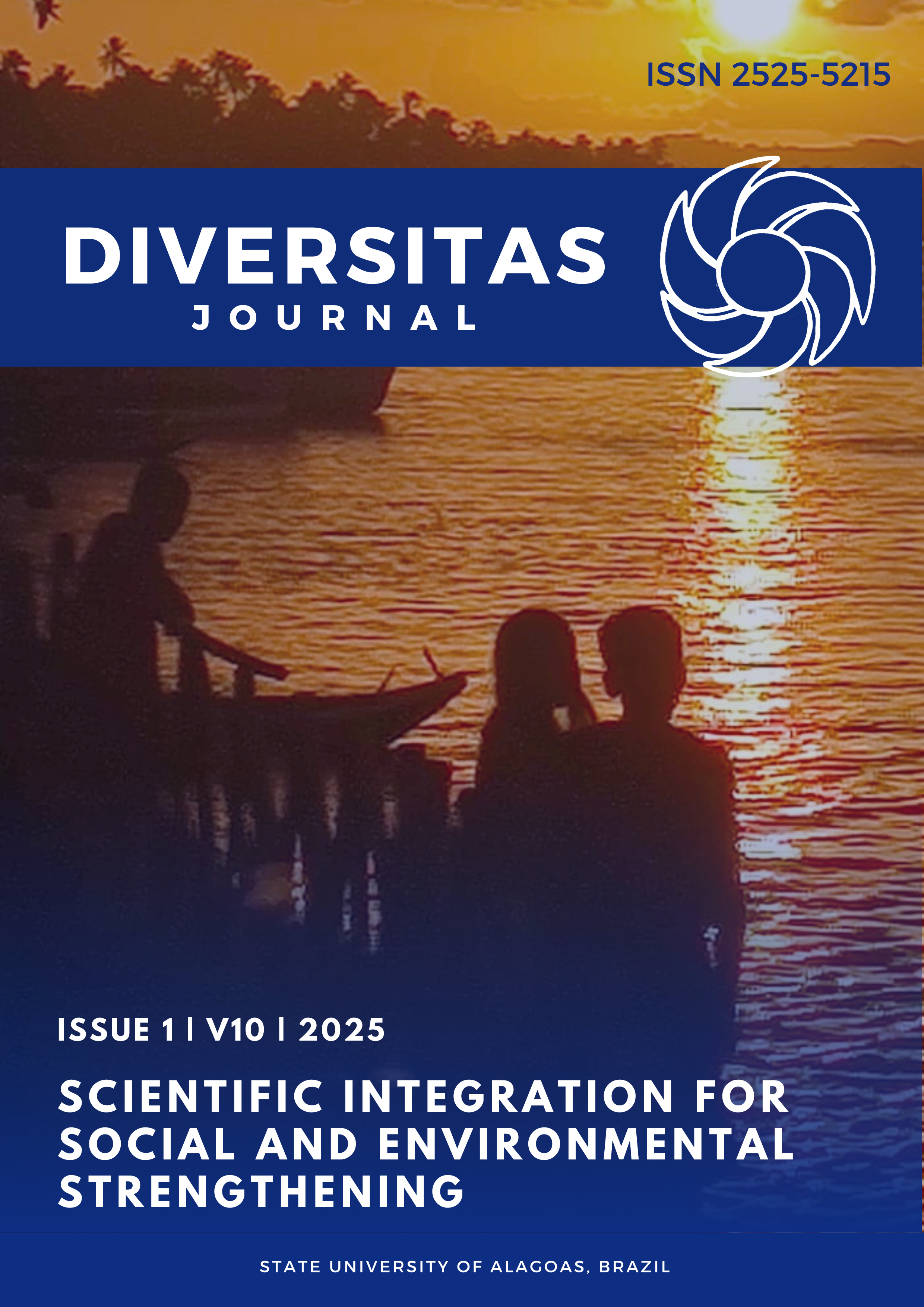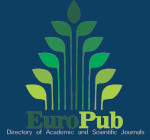Diversity and Homogenization of a Community of Euglossini Bees (Hymenoptera: Apidae) in Two Urban Forest Remnants in State of Bahia, Brazil
DOI:
https://doi.org/10.48017/dj.v10i1.2963Keywords:
Euglossine, Eulaema nigrita, Euglossa cordata, orchid bees, urban ecosystemsAbstract
Euglossini bees are a key pollinator group in the Neotropics, and as they are related to tropical forests, they are considered bioindicators of that environment. The present study aimed to investigate the community of male orchid bees in two urban forest fragments in Salvador, Bahia State, Brazil. The data comprise samples of aromatic baits in monthly campaigns from June/2018 to May/2020. We calculated the Shannon-Wiener richness index (H’) and the Pielou evenness index (J’) for each fragment studied. We used circular statistics to test for the abundance and seasonality of the most abundant species. In total, we collected n = 577 individuals of eight species. Euglossa cordata and Eulaema nigrita were the most abundant species and together accounted for over 92% of the total in both areas. Euglossine richness: H’site A = 0.92 and H’site B = -0.84 and similarity: J’site A = 0.51 and J’site B = -0.41 were similar between areas. The results confirm the absence of seasonality patterns and relationship with climate variables (p > 0.05). The homogenization of species composition in the fragments and the abundance of indicator species of anthropic environments and generalist species rekindle the discussion regarding the maintenance of ecosystem services in forest remnants of different sizes surrounded by an urban or peri-urban matrix. Forest fragments are a reality in large cities located in original areas of the Atlantic Forest biome, and they can be important for maintaining the urban pollinator fauna.
Metrics
References
Ackerman, J. D. (1983). Diversity and seasonality of male euglossine bees (Hymenoptera: Apidae) in Central Panama. Ecology, 63(2), 274–283. https://doi.org/10.2307/1937075
Aguiar, W. M., Medeiros, R. L. dos S., Aguiar, C. M. L., & Borges, I. G. M. (2017). The orchid bee communities in different phytophysiognomies in the Atlantic Forest: From lowland to montane rainforests. Sociobiology, 64(2), 182–190. https://doi.org/10.13102/sociobiology.v64i2.1348
Almeida, V. M. N., Franco, E. L., Carvalho, M. M. de, & Pereira, C. V. (2020). Atração de abelhas crepusculares e diurnas por iscas-odores em duas áreas distintas na Chapada Diamantina-Bahia. In J. M. B. de Oliveira-Junior & L. B. Calvão (Eds.), A interface do conhecimento sobre abelhas 2 (pp. 18–33). Atena Editora. https://doi.org/10.22533/at.ed.368200110
Americano-Santos, M. (2014). Sobre as abelhas euglossinas do Parque Nacional de Boa Nova, Bahia (Dissertação de Mestrado). Universidade Estadual do Sudoeste da Bahia.
Andrade-Silva, A. C. R., Nemésio, A., Oliveira, F. F. de, & Nascimento, F. S. (2012). Spatial–temporal variation in orchid bee communities (Hymenoptera: Apidae) in remnants of arboreal Caatinga in the Chapada Diamantina region, state of Bahia, Brazil. Neotropical Entomology, 41, 296–305. https://doi.org/10.1007/s13744-012-0053-9
Azevedo, L. P. (2020). Comunidade de Euglossineos (Hymenoptera: Apidae) em uma área de remanescente urbano de Mata Atlântica no município de Salvador, Bahia (Trabalho de Conclusão de Curso). Centro Universitário Jorge Amado.
Batáry, P., Kovács-Hostyánszki, A., Fischer, C., Tscharntke, T., & Holzschuh, A. (2012). Contrasting effect of isolation of hedges from forests on farmland vs. woodland birds. Community Ecology, 13, 155–161. https://doi.org/10.1556/ComEc.13.2012.2.4
Brown, J. C., Corrêa-Neto, J. J., Ribeiro, C. F., & Oliveira, M. L. (2024). The impact of agricultural colonization and deforestation on orchid bees (Apidae: Euglossini) in the Brazilian Amazon. Biological Conservation, 293, 110560. https://doi.org/10.1016/j.biocon.2024.110560
Brun, F. G. K., Longhi, S. J., & Brun, E. J. (2007). Estudo da percepção da população de vilas do Bairro Camobi, Santa Maria-RS sobre a arborização urbana. Revista de Estudos Ambientais, 11(1), 6–21. https://doi.org/10.7867/1983-1501.2015v17n2p3-5
Carneiro, L. S., Aguiar, W. M., Aguiar, C. M. L., & Santos, G. M. M. (2018). Orchid bees (Hymenoptera: Apidae: Euglossini) in seasonally dry tropical forest (Caatinga) in Brazil. Sociobiology, 65(2), 253–258. https://doi.org/10.13102/sociobiology.v65i2.2077
Coswosk, J. A., Ferreira, R. A., Soares, E. D. G., & Faria, L. R. R. (2017). Responses of euglossine bees (Hymenoptera: Apidae, Euglossina) to an edge-forest gradient in a large tabuleiro forest remnant in Eastern Brazil. Neotropical Entomology, 47(4), 447–456. https://doi.org/10.1007/s13744-017-0533-z
Devictor, V., Julliard, R., Clavel, J., Jiguet, F., Lee, A., & Couvet, D. (2008). Functional biotic homogenization of bird communities in disturbed landscapes. Global Ecology and Biogeography, 17, 252–261. https://doi.org/10.1111/j.1466-8238.2007.00364.x
Dressler, R. L. (1982). Biology of the orchid bees (Euglossini). Annual Review of Ecology, Evolution, and Systematics, 13, 373-394. https://doi.org/10.1146/annurev.es.13.110182.002105
Enríquez-Espinosa, A. C. E., Ramos, D. G., Siqueira, A. S., Dunck, B., & Ligeiro, R. (2022). Effects of small-scale anthropogenic alterations in Euglossini bees at eastern Amazon forest. Iheringia. Série Zoologia, 112, e2022010. https://doi.org/10.1590/1678-4766e2022010
Ferronato, M. C. F., Giangarelli, D. C., Mazzaro, D., Uemura, N., & Sofia, S. H. (2017). Orchid bee (Apidae: Euglossini) communities in Atlantic forest remnants and restored areas in Paraná State, Brazil. Neotropical Entomology, 47(3), 352–361. https://doi.org/10.1007/s13744-017-0530-2
Giangarelli, D. C., Aguiar, W. M. de, & Sofia, S. H. (2014). Orchid bee (Hymenoptera: Apidae: Euglossini) assemblages from three different threatened phytophysiognomies of the subtropical Brazilian Atlantic Forest. Apidologie, 46(1), 71–83. https://doi.org/10.1007/s13592-014-0303-4
Glória, P. S. (2018). Variação gênica e estrutura populacional de Euglossa cordata (Linnaeus, 1758) acessadas por meio de marcador mitocondrial e locos microssatélites. [Dissertação de Mestrado, Universidade Federal de São Carlos].
Goes, L. P., Paz, J. R. L. da, Silva, W. P., Silveira, A. S. R. B. da, Neves, E. L. das, & Pigozzo, C. M. (2021). Comunidade de abelhas em diversos métodos de amostragem: fenologia e sazonalidade de uma restinga costeira em Mangue Seco, Litoral Norte da Bahia. Candombá, 17(1), 43–59. https://web.unijorge.edu.br/sites/candomba/pdf/2019-2021/2021/iv_2021-4_Goes%20et%20al_Abelha_MSeco.pdf
Hipólito, J., Magnusson, W. E., & Baccaro, F. (2023). Optimizing survey effort for Euglossine bees in tropical forests. Perspectives in Ecology and Conservation, 21(3), 253-262. https://doi.org/10.1016/j.pecon.2023.08.001
Instituto Nacional de Meteorologia do Brasil – Inmet. Banco de dados meteorológicos históricos do INMET. Brasília, DF. (accessed date: 08 December, 2020).
Kovach, W. L. (2011). Oriana: circular statistics for windows, ver. 4. Pentraeth, United Kingdom: Kovach Computing Services.
Krug, C., & Alves-dos-Santos, I. (2008). O uso de diferentes métodos para amostragem da fauna de abelhas (Hymenoptera: Apoidea), um estudo em Floresta Ombrófila Mista em Santa Catarina. Neotropical Entomology, 37(3), 265-278. https://doi.org/10.1590/S1519-566X2008000300005
Lima, I. do N. (2017). Amplitude e sobreposição do nicho ecológico de Euglossa cordata e Eulaema nigrita (Hymenoptera, Apidae, Euglossini). [Dissertação de Mestrado, Universidade Federal do Ceará].
Magurran, A. E. (2004). Measuring biological diversity. Oxford: Blackwell Science Ltd.
Margatto, C., Berno, V. O., Gonçalves, R. B., & Faria Jr., L. R. R. (2019). Orchid bees (Hymenoptera, Apidae, Euglossini) are seasonal in Seasonal Semideciduous Forest fragments, southern Brazil. Papéis Avulsos de Zoologia, 59, e20195907. https://doi.org/10.11606/1807-0205/2019.59.07
Mateus, S., Andrade e Silva, A. C. R., & Garófalo, C. A. (2015). Diversity and temporal variation in the orchid bee community (Hymenoptera: Apidae) of a remnant of a neotropical seasonal semi-deciduous forest. Sociobiology, 62(4), 571–577. https://doi.org/10.13102/sociobiology.v62i4.391
Mattozo, V. C., Faria, L. R. R., & Melo, G. A. R. (2011). Orchid bees (Hymenoptera: Apidae) in the coastal forests of southern Brazil: diversity, efficiency of sampling methods and comparison with other Atlantic forest surveys. Papéis Avulsos de Zoologia, 51(33), 505–515. https://doi.org/10.1590/S0031-10492011003300001
Medeiros, R. L. dos S. (2014). Riqueza e abundância de espécies em comunidades de abelhas Euglossina (Hymenoptera; Apidae) no corredor central da Mata Atlântica. [Dissertação de Mestrado, Universidade Estadual de Feira de Santana].
Medeiros, R. L. S., Aguiar, W. M., Aguiar, C. M. L., & Borges, I. G. M. (2017). The orchid bee communities in different phytophysiognomies in the Atlantic Forest: from lowland to montane rainforests. Sociobiology, 64(2), 182-190. https://doi.org/10.13102/sociobiology.v64i2.1348
Melo, A. G. C. de, Carvalho, D. A. de, Castro, G. C. de, & Machado, E. L. M. (2011). Fragmentos florestais urbanos. Revista Científica Eletrônica de Engenharia Florestal, 17(1), 58–79.
Melo, B. F., & Pigozzo, C. M. (2017). Comunidade de abelhas euglossíneos em remanescente florestal de Amélia Rodrigues, BA. CONIC – Congresso Nacional de Iniciação Científica - SEMESP, pp. 1–4.
Menezes, J. P., Alves Júnior, V. V., Henrique, J. A., & Lobtchenko, G. (2023). Would Eulaema nigrita (Hym.: Apidae: Euglossini) be a reliable organism as a bioindicator of degraded environments?. Contribuciones a las Ciencias Sociales, 16(11), 26611–26626. https://doi.org/10.55905/revconv.16n.11-111
Michener, C. D. (2000). The bees of the world. Baltimore: The Johns Hopkins University. 913p.
Miranda, E. A., Carvalho, A. F., Gomes-Miranda, J. J., Souza, C. R., & Costa, M. A. (2019). Priority areas for conservation of orchid bees (Apidae, Euglossini) in the Atlantic Forest. Journal of Insect Conservation, 23(3), 613–621. https://doi.org/10.1007/s10841-019-00155-9
Moreira, E. F., Santos, R. L. da S., Silveira, M. S., Boscolo, D., Neves, E. L. das, & Viana, B. F. (2017). Influence of landscape structure on Euglossini composition in open vegetation environments. Biota Neotropica, 17(1), e20160294. https://doi.org/10.1590/1676-0611-bn-2016-0294
Morellato, L. P. C., Alberti, L. F., & Hudson, I. L. (2010). Applications of circular statistics in plant phenology: a case studies approach. Universidade Estadual Paulista, Rio Claro, São Paulo.
Moure, J. S., Melo, G. A. R., & Faria Jr., L. R. R. (2012). Euglossini Latreille, 1802. In: J. S. Moure, D. Urban, & G. A. R. Melo (Eds.) Catalogue of bees (Hymenoptera, Apoidea) in the Neotropical Region, online version.
Myers, N., Mittermeier, R. A., Mittermeier, C. G., Fonseca, G. A. B., & Kent, J. (2000). Biodiversity hotspots for conservation priorities. Nature, 403, 853-858. https://doi.org/10.1038/35002501
Nemésio, A., & Silveira, A. F. (2006). Edge effects on the orchid-bee fauna (Hymenoptera, Apidae) at a large remnant of Atlantic rain forest in southeastern Brazil. Neotropical Entomology, 35, 313-323. https://doi.org/10.1590/S1519-566X2006000300004
Nemésio, A., & Silveira, F. A. (2007). Orchid bee fauna (Hymenoptera: Apidae: Euglossina) of Atlantic Forest fragments inside an urban area in southeastern Brazil. Neotropical Entomology, 36(2), 186–191. https://doi.org/10.1590/S1519-566X2007000200003
Nemésio, A. (2009). Orchid bees (Hymenoptera: Apidae) of the Brazilian Atlantic Forest. Zootaxa, 2041(1), 1–242. https://doi.org/10.11646/zootaxa.2041.1.1
Nemésio, A. (2013a). The orchid-bee faunas (Hymenoptera: Apidae) of “Parque Nacional do Monte Pascoal”, “Parque Nacional do Descobrimento” and three other Atlantic Forest remnants in southern Bahia, eastern Brazil. Brazilian Journal of Biology, 73(2), 437–446. https://doi.org/10.1590/S1519-69842013000200028
Nemésio, A. (2013b). The orchid-bee faunas (Hymenoptera: Apidae) of two Atlantic Forest remnants in southern Bahia, eastern Brazil. Brazilian Journal of Biology, 73(2), 375–381. https://doi.org/10.1590/S1519-69842013000200018
Nemésio, A. (2013c). The orchid-bee fauna (Hymenoptera: Apidae) of ‘Reserva Biológica de Una’, a hotspot in the Atlantic Forest of southern Bahia, eastern Brazil. Brazilian Journal of Biology, 73(2), 347–352. https://doi.org/10.1590/S1519-69842013000200014
Neves, E. L. & Viana, B. F. (1997). Inventário da fauna de Euglossinae (Hymenoptera, Apidae) do baixo sul da Bahia, Brasil. Revista Brasileira de Zoologia, 14(4), 831–837. https://doi.org/10.1590/S0101-81751997000400007
Oliveira, M. L. (1999). Sazonalidade e horário de atividade de abelhas Euglossina (Hymenoptera, Apidae) em florestas de terra firme na Amazônia Central. Revista Brasileira de Zoologia, 16, 83-90. https://doi.org/10.1590/S0101-81751999000100003
Oliveira, M. L. & Campos, L. A. O. (1995). Abundância, riqueza e diversidade de abelhas Euglossinae (Hymenoptera: Apidae) em florestas contínuas de terra firme na Amazônia Central, Brasil. Revista Brasileira de Zoologia, 12, 547-556. https://doi.org/10.1590/S0101-81751995000300009
Peruquetti, R. C., Campos, L. A. de O., Coelho, C. D. P., Abrantes, C. V. M., & Lisboa, L. C. de O. (1999). Abelhas Euglossini (Apidae) de áreas de Mata Atlântica: abundância, riqueza e aspectos biológicos. Revista Brasileira de Zoologia, 16(suppl 2), 101–118. https://doi.org/10.1590/S0101-81751999000600012
Pinto, A. R., Silveira, G. D. C., Gaglianone, M. C., & Freitas, L. (2019). Abrupt decrease in the diversity of Euglossini bees (Hymenoptera: Apidae) in a montane rainforest. Journal of Apicultural Research, 58(5), 682–693. https://doi.org/10.1080/00218839.2019.1637223
R Development Core Team (version 4.2.2). R: A language and environment for statistical computing. Published online 2023. https://www.R-project.org/ (accessed Jan 2023).
Ramalho, A. V., Gaglianone, M. C., & Oliveira, M. L. de. (2009). Comunidades de abelhas Euglossina (Hymenoptera, Apidae) em fragmentos de Mata Atlântica no Sudeste do Brasil. Revista Brasileira de Entomologia, 53(1), 95–101. https://doi.org/10.1590/S0085-56262009000100022
Ramalho, M., Rosa, J. F., Dantas E Silva, M., Silva, M., & Monteiro, D. (2013). Spatial distribution of orchid bees in a rainforest/rubber agro-forest mosaic: habitat use or connectivity. Apidologie, 44(4), 385–403. https://doi.org/10.1007/s13592-012-0189-y
Rebêlo, J. M. M., & Garófalo, C. A. (1991). Diversidade e sazonalidade de machos de Euglossini (Hymenoptera, Apidae) e preferências por iscas-odores em um fragmento de floresta no sudeste do Brasil. Revista Brasileira de Biologia, 51, 787-799.
Ribeiro, M. G. (2017). A influência da paisagem na forma e no tamanho da asa de três espécies de Euglossini (Hymenoptera; Apidae). [Dissertação de Mestrado, Universidade Estadual de Feira de Santana].
Ribeiro, M. G., Aguiar, W. M., Nunes, L. A., & Carneiro, L. S. (2019). Morphometric changes in three species of euglossini (Hymenoptera: Apidae) in response to landscape structure. Sociobiology, 66(2), 339–347. https://doi.org/10.13102/sociobiology.v66i2.3779
Santos, B. R. (2020). Comunidade de abelhas Euglossina em remanescente urbano de Mata Atlântica no Parque Pedra de Xangô, Salvador, Ba. [Trabalho de Conclusão de Curso, Centro Universitário Jorge Amado].
Santos, R. L. da S., Pigozzo, C. M., & Neves, E. L. das. (2014). Riqueza e abundância de abelhas (Hymenoptera, Apidae, Apinae, Euglossini) em um remanescente urbano de Mata Atlântica do Município de Salvador, Bahia, Brasil. Candombá, 10(1), 81–92. https://web.unijorge.edu.br/sites/candomba/pdf/artigos/2014/a9.pdf
Silva, M., Ramalho, M., Aguiar, C. M. L., & Dantas E Silva, M. (2017). Apifauna (Hymenoptera, Apoidea) em uma área de restinga arbórea-mata atlântica na costa atlântica do Nordeste do Brasil. Magistra, 27(1), 110-121. https://periodicos.ufrb.edu.br/index.php/magistra/article/view/3899
Silveira, F. A., Melo, G. A. R., & Almeida, E. A. B. (2002). Abelhas brasileiras: sistemática e identificação. Fundação Araucária. 253p.
Viana, B. F., Kleinert, A. M. P., & Neves, E. L. das. (2002). Comunidade de Euglossini (Hymenoptera, Apidae) das dunas litorâneas do Abaeté, Salvador, Bahia, Brasil. Revista Brasileira de Entomologia, 46(4), 539–545. https://doi.org/10.1590/S0085-56262002000400008
Zar, J. H. (1996). Biostatistical analysis. 3rd ed., New Jersey: Prentice-Hall International Editions.
Downloads
Published
How to Cite
Issue
Section
License
Copyright (c) 2025 Beatriz Santos, Lainne Azevedo, Joicelene Regina Lima da Paz, Wagner Silva, Edinaldo Luz das Neves, Camila Pigozzo

This work is licensed under a Creative Commons Attribution 4.0 International License.
The Diversitas Journal expresses that the articles are the sole responsibility of the Authors, who are familiar with Brazilian and international legislation.
Articles are peer-reviewed and care should be taken to warn of the possible incidence of plagiarism. However, plagiarism is an indisputable action by the authors.
The violation of copyright is a crime, provided for in article 184 of the Brazilian Penal Code: “Art. 184 Violating copyright and related rights: Penalty - detention, from 3 (three) months to 1 (one) year, or fine. § 1 If the violation consists of total or partial reproduction, for the purpose of direct or indirect profit, by any means or process, of intellectual work, interpretation, performance or phonogram, without the express authorization of the author, the performer, the producer , as the case may be, or whoever represents them: Penalty - imprisonment, from 2 (two) to 4 (four) years, and a fine. ”















.png)




